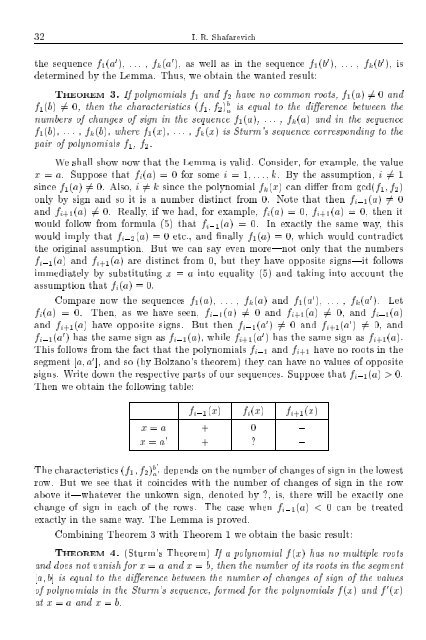SELECTED CHAPTERS FROM ALGEBRA I. R. Shafarevich Preface
SELECTED CHAPTERS FROM ALGEBRA I. R. Shafarevich Preface
SELECTED CHAPTERS FROM ALGEBRA I. R. Shafarevich Preface
Create successful ePaper yourself
Turn your PDF publications into a flip-book with our unique Google optimized e-Paper software.
32 I. R. <strong>Shafarevich</strong>the sequence f 1 (a 0 ), ... , f k (a 0 ), as well as in the sequence f 1 (b 0 ), ... , f k (b 0 ), isdetermined by the Lemma. Thus, we obtain the wanted result:THEOREM 3. If polynomials f 1 and f 2 have no common roots, f 1 (a) 6= 0andf 1 (b) 6= 0, then the characteristics (f 1 f 2 ) b a is equal to the dierence between thenumbers of changes of sign in the sequence f 1 (a), ... , f k (a) and in the sequencef 1 (b), ... , f k (b), where f 1 (x), ... , f k (x) is Sturm's sequence corresponding to thepair of polynomials f 1 , f 2 .We shall show now that the Lemma is valid. Consider, for example, the valuex = a. Suppose that f i (a) =0for some i =1 ...k. By the assumption, i 6= 1since f 1 (a) 6= 0. Also, i 6= k since the polynomial f k (x) can dier from gcd(f 1 f 2 )only by sign and so it is a number distinct from 0. Note that then f i;1(a) 6= 0and f i+1 (a) 6= 0. Really, if we had,for example, f i (a) =0,f i+1 (a) =0, then itwould follow from formula (5) that f i;1(a) = 0. In exactly the same way, thiswould imply that f i;2(a) = 0 etc., and nally f 1 (a) = 0, which would contradictthe original assumption. But we can say even more|not only that the numbersf i;1(a) and f i+1 (a) are distinct from 0, but they have opposite signs|it followsimmediately by substituting x = a into equality (5) and taking into account theassumption that f i (a) =0.Compare now the sequences f 1 (a), ... , f k (a) and f 1 (a 0 ), ... , f k (a 0 ). Letf i (a) = 0. Then, as we have seen, f i;1(a) 6= 0 and f i+1 (a) 6= 0, and f i;1(a)and f i+1 (a) have opposite signs. But then f i;1(a 0 ) 6= 0 and f i+1 (a 0 ) 6= 0, andf i;1(a 0 ) has the same sign as f i;1(a), while f i+1 (a 0 ) has the same sign as f i+1 (a).This follows from the fact that the polynomials f i;1 and f i+1 have no roots in thesegment [a a 0 ], and so (by Bolzano's theorem) they can have novalues of oppositesigns. Write down the respective parts of our sequences. Suppose that f i;1(a) > 0.Then we obtain the following table:f i;1(x) f i (x) f i+1 (x)x = a + 0 ;x = a 0 + ? ;The characteristics (f 1 f 2 ) b0 a0 depends on the number of changes of sign in the lowestrow. But we see that it coincides with the number of changes of sign in the rowabove it|whatever the unkown sign, denoted by ?, is, there will be exactly onechange of sign in each of the rows. The case when f i;1(a) < 0 can be treatedexactly in the same way. The Lemma is proved.Combining Theorem 3 with Theorem 1 we obtain the basic result:THEOREM 4. (Sturm's Theorem) If a polynomial f(x) has no multiple rootsand does not vanish for x = a and x = b, then the number of its roots in the segment[a b] is equal to the dierence between the number of changes of sign of the valuesof polynomials in the Sturm's sequence, formed for the polynomials f(x) and f 0 (x)at x = a and x = b.
















